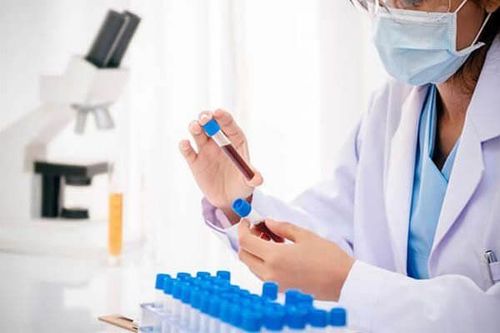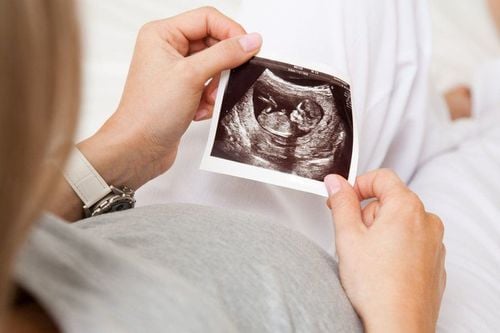This is an automatically translated article.
Down syndrome in children is not uncommon and it has a serious impact on a child's development. If a woman gives birth to one child with Down syndrome, the risk of a second baby also having Down syndrome is slightly increased.1. What is Down syndrome?
Down syndrome is a condition in which a person has an extra chromosome. Usually a baby is born with 46 chromosomes, but babies with Down Syndrome have an extra copy of chromosome 21, known medically as triploid 21. This extra copy changes the way the baby's brain and body develop, causing serious problems both physically and mentally.Although people with Down syndrome look and act similar, each person has different abilities. People with Down often have an IQ (Intelligence Index) in the low to moderate range and are slower to speak than other children.
Trắc nghiệm: Nhận biết sớm dấu hiệu chậm phát triển thể chất và trí tuệ ở trẻ
Nếu 6 tuổi không biết đếm số, 7 tuổi vẫn chưa phân biệt được giữa thực tế và tưởng tượng thì có thể bé chậm phát triển thể chất và trí tuệ hơn so với bạn bè cùng lứa. Bạn đã nhận biết được các dấu hiệu bất thường sớm này chưa? Cùng làm nhanh bài trắc nghiệm sau để trang bị thêm kiến thức cho mình nhé!
The following content is prepared under supervision of Thạc sĩ, Bác sĩ y khoa, Ma Văn Thấm , Nhi , Phòng khám Đa khoa Quốc tế Vinmec Dương Đông(Phú Quốc)
2. Physical Features of Down's Syndrome
Some common physical features of Down syndrome include:Slanted eyes, raised eyelids, sometimes crossed, skin folds covering the eyelids, slightly swollen and red eyes. The inside of the black has many small white dots like sand grains and usually disappear after 12 months of age. Low muscle tone Small stature and short neck Single deep fold on center of palms Mouth protruding and always open, palate high, thick tongue sticking out Short limbs, short, large hands. The fingers are short, the little finger is often clubbed. The palm of the hand has deep folds lying on the side. Flat feet, crow's toes, outstretched big toes; the gap between the big toe and the second toe is too wide Loose elbows, hips, knees, ankles Small head Undeveloped genitals, infertility Growth retardation

3. Causes of Down Syndrome
Human cells contain 23 pairs of chromosomes, with one chromosome from the father and the other from the mother. Down syndrome is the result of abnormal cell division, in this case chromosome 21, which causes cells to have some or all of the extra chromosome 21.Three genetic variants that can cause Down syndrome include:
Trisomy 21, which accounts for 95% of cases. Because of this genetic variation, people with Down syndrome have up to 3 copies of chromosome 21 in every cell, instead of the normal 2. This is the result of abnormal cell division during the development of sperm or egg cells. Mosaic Down syndrome. This is a rare form of Down, in which a person has only a few cells with an extra copy of chromosome 21. Abnormal cell division after fertilization causes mosaicism of normal and abnormal cells. is often the cause of this form of Down Syndrome. Translocation Down syndrome. Down syndrome can also occur when, before or during fertilization, a segment of chromosome 21 is attached to another chromosome. Children with this form of Down Syndrome usually have 2 copies of chromosome 21, but also have the inheritance of chromosome 21 "mistletically" on the other chromosome. To date, no environmental or behavioral trigger has been shown to cause Down Syndrome. After a lot of research into cell division errors, the researchers discovered:
In most cases, the extra copy of chromosome 21 comes from the mother, in the egg. A small number (less than 5%) of residual copies come from the father, via sperm. The remaining cases of cell division errors occur after fertilization, when the fetus begins to develop.
4. Risk factors

4.1 Maternal age at pregnancy The higher the maternal age, the greater the risk of having a baby with Down syndrome.
25-year-old pregnant mother: the rate of fetus with Down syndrome is quite low, only 1:1200 Pregnant women over 35 years old: this ratio is 1:350 40-year-old pregnant mother: the ratio of fetuses with this disease is 1:100 45 years old: high rate 1:30 Pregnant mother 49 years old: the fetus has this syndrome very high 1:10 4.2 Carriers of genetic translocation causing Down Syndrome Both men and women have the ability to inherit passed on to the next generation the genetic mutation that causes Down syndrome.
4.3 Have been pregnant or given birth to a baby with Down syndrome The risk of having another baby or having a future baby with the disease is 1:100. Couples should consult with a specialist or geneticist to assess their risk before deciding to have another child.
5. How to avoid it
There is currently no way to prevent Down Syndrome. If you are at high risk of having a baby with Down Syndrome, or you already have a baby with Down Syndrome, consult a specialist before becoming pregnant. A specialist can help you understand what your odds of having a baby with Down Syndrome are, what prenatal tests should be done, and the pros and cons of these tests.Therefore, for the prevention and early detection of Down syndrome, regular prenatal check-ups are extremely important. Down syndrome can be screened as early as the 9th week of pregnancy. NIPT test, with the outstanding advantage of being non-invasive, completely harmless to the fetus and can be performed as early as 8 weeks onwards, NIPT is recommended to be indicated for high-risk subjects and routine implementation at Vinmec.
Fully complying with ILLUMINA's strict recommended standards, the NIPT non-invasive prenatal screening technique at Vinmec is considered the "key" to decode fetal malformations, bringing outstanding improvement in outcomes prenatal screening results. Analytical results will be available in about 1-2 weeks and will be evaluated by genetic pathologists at the Institute of Stem Cell and Gene Technology. Customers will be consulted specifically about possible risks, especially for false positive / negative cases to have appropriate intervention direction.
As a key area of Vinmec Health system, Pediatrics Department always brings satisfaction to customers and is highly appreciated by industry experts with:
Gathering a team of top doctors and nurses in Pediatrics : consists of leading experts with high professional qualifications (professors, associate professors, doctorates, masters), experienced, worked at major hospitals such as Bach Mai, 108.. Doctors All doctors are well-trained, professional, conscientious, knowledgeable about young psychology. In addition to domestic pediatric specialists, the Department of Pediatrics also has the participation of foreign experts (Japan, Singapore, Australia, USA) who are always pioneers in applying the latest and most effective treatment regimens. . Comprehensive services: In the field of Pediatrics, Vinmec provides a series of continuous medical examination and treatment services from Newborn to Pediatric and Vaccine,... according to international standards to help parents take care of their baby's health from birth to childhood. from birth to adulthood Specialized techniques: Vinmec has successfully deployed many specialized techniques to make the treatment of difficult diseases in Pediatrics more effective: neurosurgery - skull surgery, stem cell transplantation. blood in cancer treatment. Professional care: In addition to understanding children's psychology, Vinmec also pays special attention to the children's play space, helping them to have fun and get used to the hospital's environment, cooperate in treatment, improve the efficiency of medical treatment.
SEE ALSO:
3 landmark ultrasound fetal malformations pregnant women need to remember Causes of Down malformation in fetus Meaning of ultrasound in obstetrics
Please dial HOTLINE for more information or register for an appointment HERE. Download MyVinmec app to make appointments faster and to manage your bookings easily.














